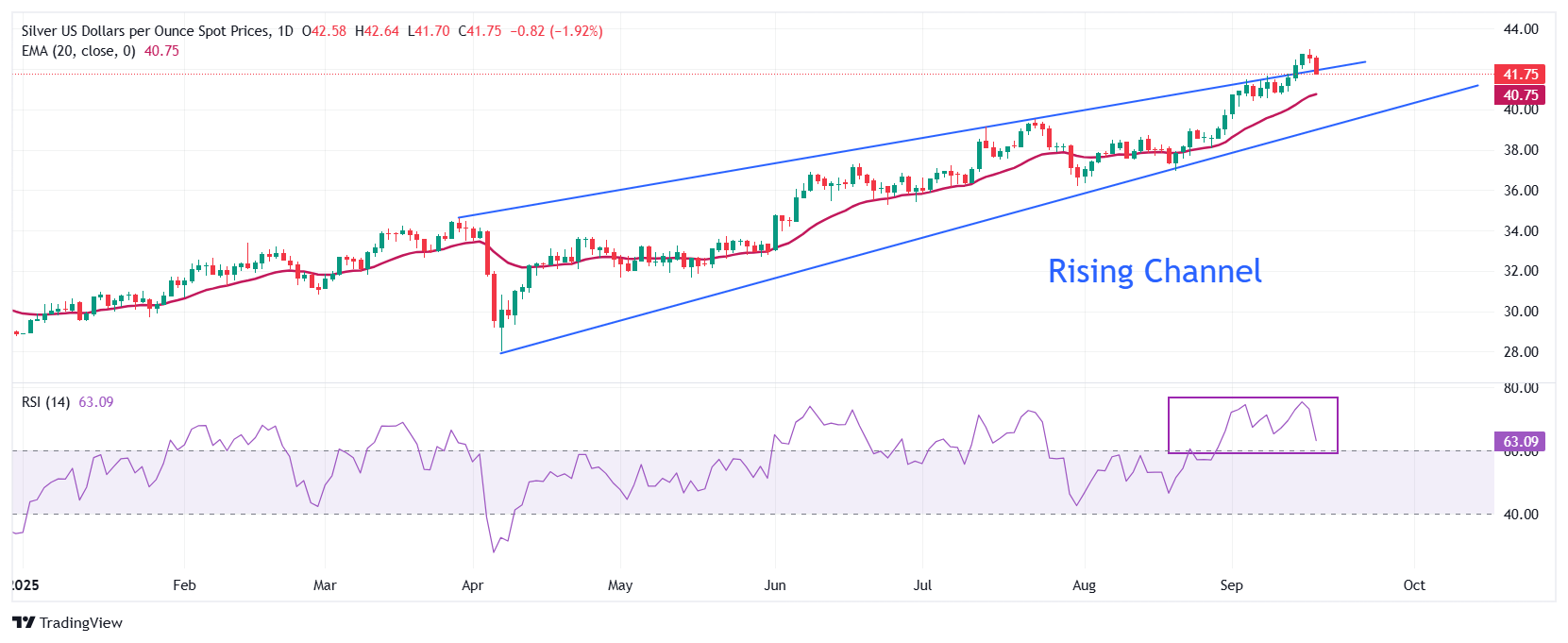Silver Price Forecast: XAG/USD plunges to near $41.70 ahead of Fed’s monetary policy outcome
- Silver price plummets to near $41.70 ahead of the Fed and BoC’s monetary policy announcement.
- Both the Fed and the BoC are expected to cut interest rates.
- Investors will also focus on the Fed’s dot plot and Summary of Economic Projections.
Silver price (XAG/USD) is down almost 2% to near $41.70 during the European trading session on Wednesday. The white metal dives swiftly ahead of the Federal Reserve’s (Fed) monetary policy announcement at 18:00 GMT.
The Fed is nearly certain to cut interest rates in its policy meeting as risks to the United States (US) labor market have increased and the impact of tariffs on inflation doesn’t appear to be persistent.
According to the CME FedWatch tool, traders see a 96% chance that the Fed will reduce interest rates by 25 basis points (bps) to 4.00%-4.25%, while the rest support a bigger reduction of 50 bps.
Theoretically, lower interest rates by the Fed bode well for non-yielding assets, such as Silver.
In the monetary policy announcement, investors will also focus on the Fed’s dot plot, which shows where policymakers see interest rates heading in the near and long term, and the Summary of Economic Projections (SEP).
Analysts at Deutsche Bank have projected the Fed to cut interest rates in all three policy meetings remaining this year.
In Wednesday’s session, investors will also focus on the Bank of Canada’s (BoC) monetary policy announcement at 13:45 GMT. The BoC is expected to cut interest rates by 25 basis points (bps) to 2.5%.
Silver technical analysis
Silver price faces selling pressure near the upper end of the Rising Channel formation. However, the near-term trend of the white metal remains bullish as the 20-day Exponential Moving Average (EMA) slopes higher around $40.75.
The 14-day Relative Strength Index (RSI) cools down to near 63.00, and is likely to find cushion near 60.00. A fresh bullish momentum would emerge if the RSI holds above 60.00.
Looking down, the psychological figure of $40.00 will be a key support for the Silver price. On the upside, the September 16 high of $43.00 will be a major barrier.
Silver daily chart

Silver FAQs
Silver is a precious metal highly traded among investors. It has been historically used as a store of value and a medium of exchange. Although less popular than Gold, traders may turn to Silver to diversify their investment portfolio, for its intrinsic value or as a potential hedge during high-inflation periods. Investors can buy physical Silver, in coins or in bars, or trade it through vehicles such as Exchange Traded Funds, which track its price on international markets.
Silver prices can move due to a wide range of factors. Geopolitical instability or fears of a deep recession can make Silver price escalate due to its safe-haven status, although to a lesser extent than Gold's. As a yieldless asset, Silver tends to rise with lower interest rates. Its moves also depend on how the US Dollar (USD) behaves as the asset is priced in dollars (XAG/USD). A strong Dollar tends to keep the price of Silver at bay, whereas a weaker Dollar is likely to propel prices up. Other factors such as investment demand, mining supply – Silver is much more abundant than Gold – and recycling rates can also affect prices.
Silver is widely used in industry, particularly in sectors such as electronics or solar energy, as it has one of the highest electric conductivity of all metals – more than Copper and Gold. A surge in demand can increase prices, while a decline tends to lower them. Dynamics in the US, Chinese and Indian economies can also contribute to price swings: for the US and particularly China, their big industrial sectors use Silver in various processes; in India, consumers’ demand for the precious metal for jewellery also plays a key role in setting prices.
Silver prices tend to follow Gold's moves. When Gold prices rise, Silver typically follows suit, as their status as safe-haven assets is similar. The Gold/Silver ratio, which shows the number of ounces of Silver needed to equal the value of one ounce of Gold, may help to determine the relative valuation between both metals. Some investors may consider a high ratio as an indicator that Silver is undervalued, or Gold is overvalued. On the contrary, a low ratio might suggest that Gold is undervalued relative to Silver.

